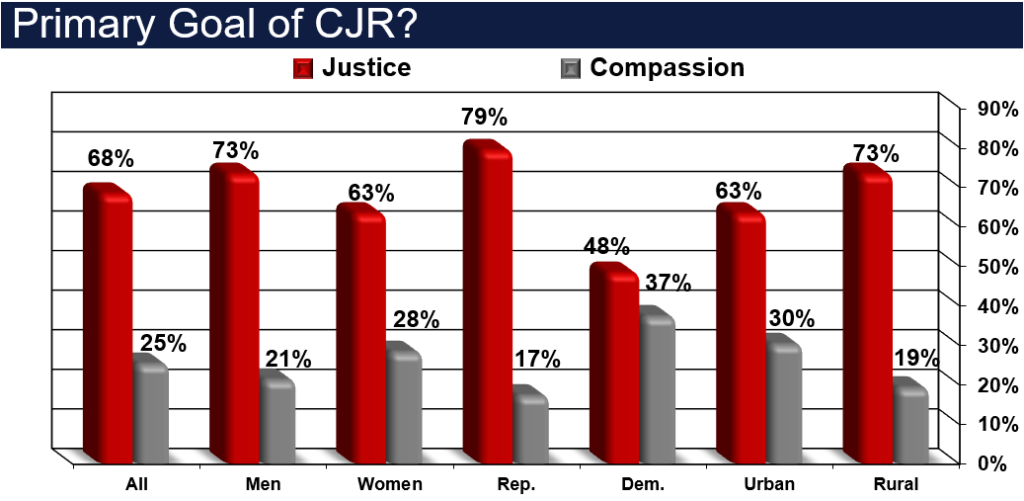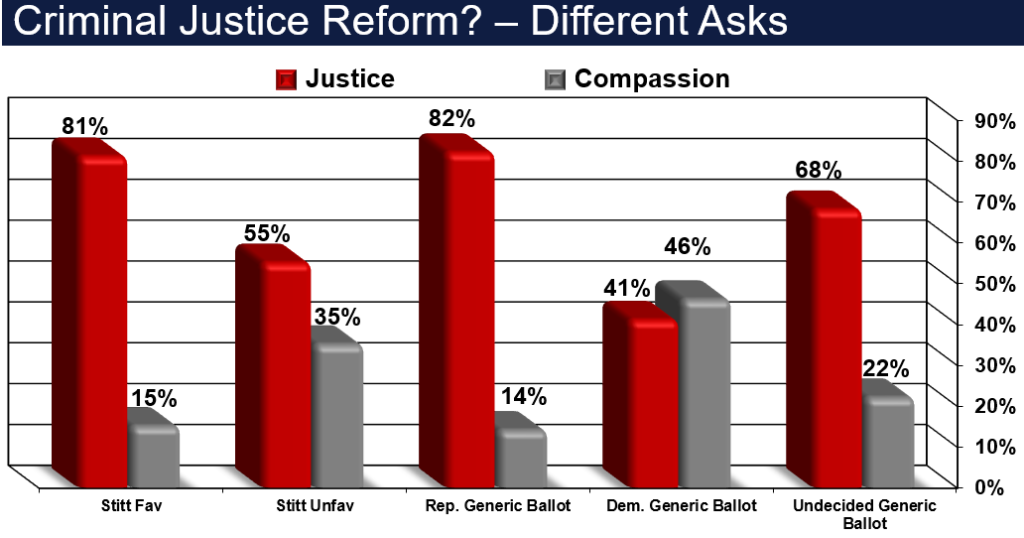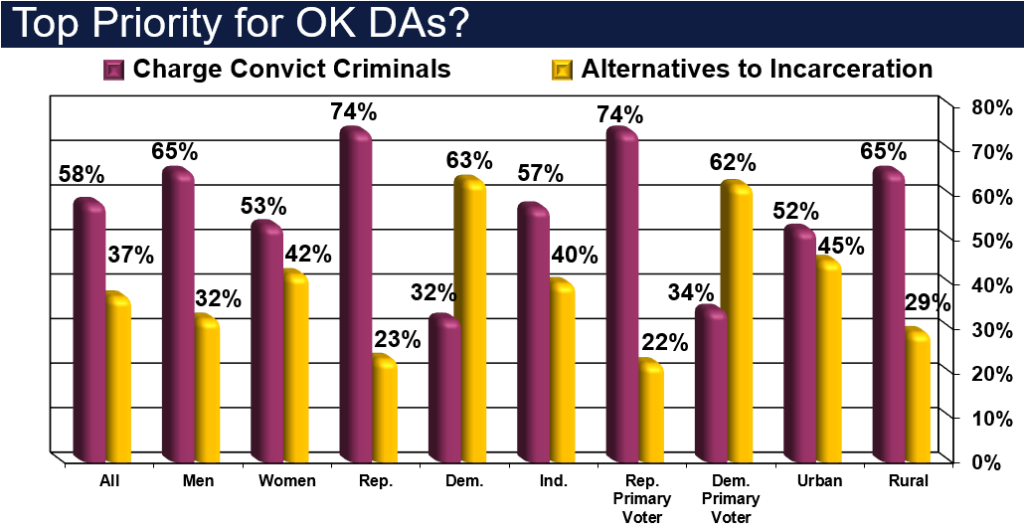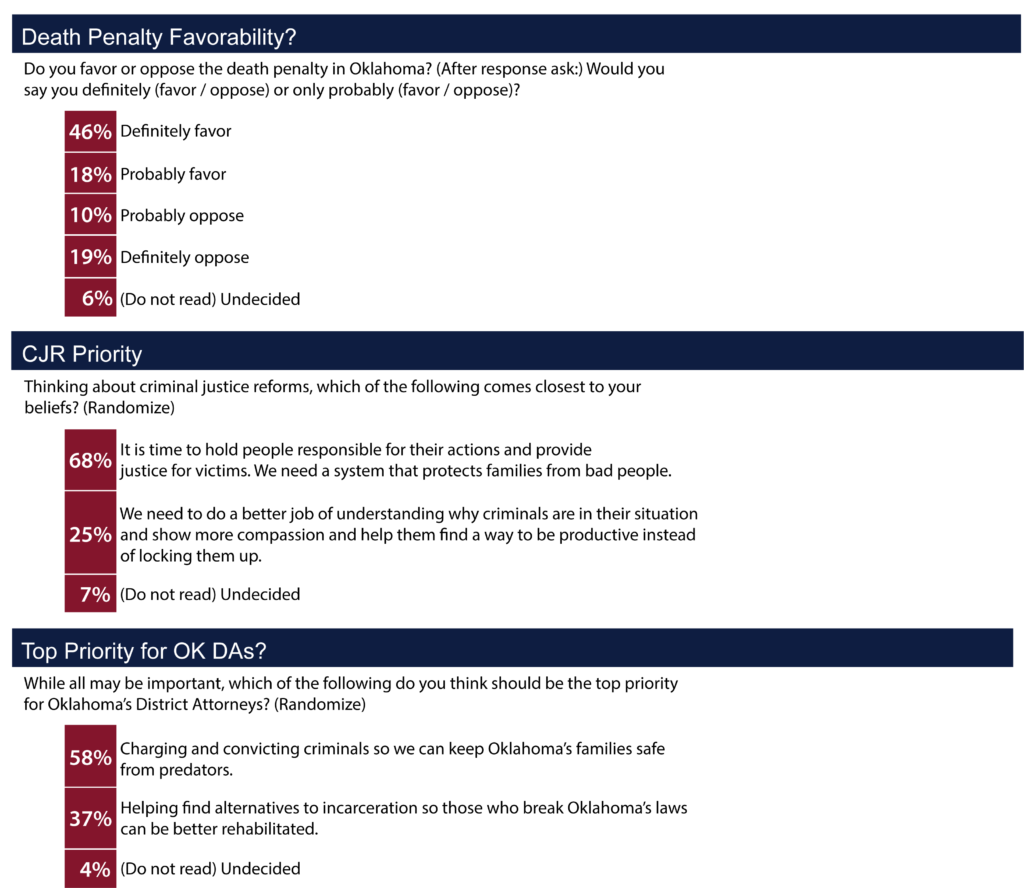Despite high profile cases, Two-thirds support death penalty
Sooner Survey: Volume 35 No. 4 | August 3, 2023
By Pat McFerron, President
Cole Hargrave Snodgrass & Associate
![]() @McFerron
@McFerron
Too often, politicians and others try to force choices when the reality is, voters want an all of the above. One need look no further than criminal justice reform efforts. It is a given, voters don’t want to lock-up those violating simple drug possession laws (they proved that by voting for SQ 780 in 2016). But that does not mean they want a soft-on-crime approach.
They proved that with the overwhelming defeat of SQ 805 which sought to lessen time in prison for repeat violators of Oklahoma’s laws. As someone who did polling in favor of SQ 780, opposing SQ 805, and consulting on Marsy’s Law for victim rights (which garnered 78% as SQ 794 in 2018) I will argue there is no conflict with voters here. Of course, any campaign can shape the discussion, but our polling shows voters are very consistent in their desire for a strong public safety presence in this state.
The death penalty is a case in point. From our firm’s first look at the death penalty until today, we have seen support range from 64% to 67%. When they voted on this issue (SQ 776 in 2016) 66.36% voted in support of the state question. In our latest survey, support for the death penalty sits at 65% with fewer than half that many (29%) saying they oppose it. More striking is that 46% say they definitely favor capital punishment while only 19% ardently oppose it. This issue should be a tough political decision for Democrats as this issue divides members of that party (41% Favor vs. 53% Oppose), but largely unites Republicans (77% Favor vs. 16% Oppose). In rural Oklahoma we see very strong support (75% Favor vs. 17% Oppose) and we still see substantial majority support in the two great metro areas (56% Favor vs. 40% Oppose).
What is fascinating about these numbers is that high profile cases, celebrity interventions, and political rhetoric have not changed opinions. Before Kim Kardashian cared about Julius Jones, two-thirds of Oklahomans supported the death penalty, virtually identical to what we see today. Prior to the state having complications with its drug cocktails, two-thirds supported the death penalty – and that is still true today. There are numerous other interventions that have occurred, and none have changed the fundamental fact that two-thirds of Oklahoma voters support the death penalty.
Of course, while one person’s poll shows support for the death penalty, you can find others saying voters don’t want an innocent person put to death. While positioned as opposite findings, these two ideas are not inherently in conflict.
Criminal justice reform efforts are similar. We have seen polling showing voters don’t want Oklahoma to incarcerate as many people as it does – but when you dig into particulars, it is difficult to determine who they want set free. They all agree on low-level property crimes and simple drug possession – two crimes that are no longer incarcerable offenses since passage of SQ 780. This study took a step back and asked Oklahomans to express their views not on the details, but on their basic approach to prosecution and criminal justice reforms. For those wanting a full revamp of Oklahoma law, these should be sobering findings.
When voters are asked what the priority of district attorneys should be, 58% say it should be charging and convicting criminals while 37% opt for finding alternatives to incarceration so better rehabilitation could occur. Of course, most would hope both could be accomplished, but if voters are asked to pick between those two sides, it is very clear where they will fall.
The partisan gap on the priority for DAs is wider than we see on the death penalty. We still have three-quarters of Republicans (74%) on the law and order side, but Democrats are close to inverted with 63% on the side of incarceration alternatives and just under a third (32%) on the tough on crime side. For all regions (including metro areas) as well as age and income groups, we see majority support for the tough on criminals side. This does narrow among those under the age of 45 (52% Charge / Convict; 44% Alternatives / Rehab), but really widens over that age. This is one place where those in homes making less than $50,000 a year (59% Charge / Convict) and those with household earnings exceeding $150,000 per annum (58% Charge / Convict) look very similar.
When we look at the goals for criminal justice reforms effort, the tough-on-crime stance of Oklahomans is even more clear. Almost seven-in-ten (68%) say “it is time to hold people responsible for their actions and provide justice for victims. We need a system that protects families from bad people”, while just a quarter (25%) prefer a system that does “a better job of understanding why criminals are in their situation…and help them find a way to be productive instead of locking them up”. Clearly, there is no desire for Oklahomans to rid our prisons of criminals. As one might suspect, Republicans are the most bullish with 79% wanting justice for victims, but they are joined by a solid plurality of Democrats (48%) on this issue. Even in the two metro areas, 63% say justice and protecting families should be the priority of any reform.
Those who have a favorable impression of statewide Republicans with the ability to take noteworthy stands come decisively down on the side of justice for victims. Among those with a favorable impression of Governor Stitt, 81% choose the justice option while only 15% select the compassion / rehab statement. We see similar numbers among those with a favorable impression of AG Drummond (71% Justice / Protection vs. 23% Compassion / Rehab). Among those undecided on a generic legislative ballot, we see very strong support for the tough on crime aspect (68%) than for rehab (22%), and those supporting a generic Republican are very strong (82% Justice / Protection) while those supporting an unnamed Democrat are more evenly split, leaning slightly toward compassion and rehab (46%) than opting for justice and protection (41%).
As someone who has been intricately involved in both sides of elections involving criminal justice issues, there is no doubt that safety and justice for victims emerges as the priority for voters. While I see little opposition to efforts easing assimilation back into society or efforts to provide second (or even third) chances, they are only supported as long as the safety of self and family are not threatened. That is why simple drug possession laws were able to be changed, but further efforts that don’t take into account a person being responsible for their own actions are landmines for CJR proponents. ◊













Recent Comments